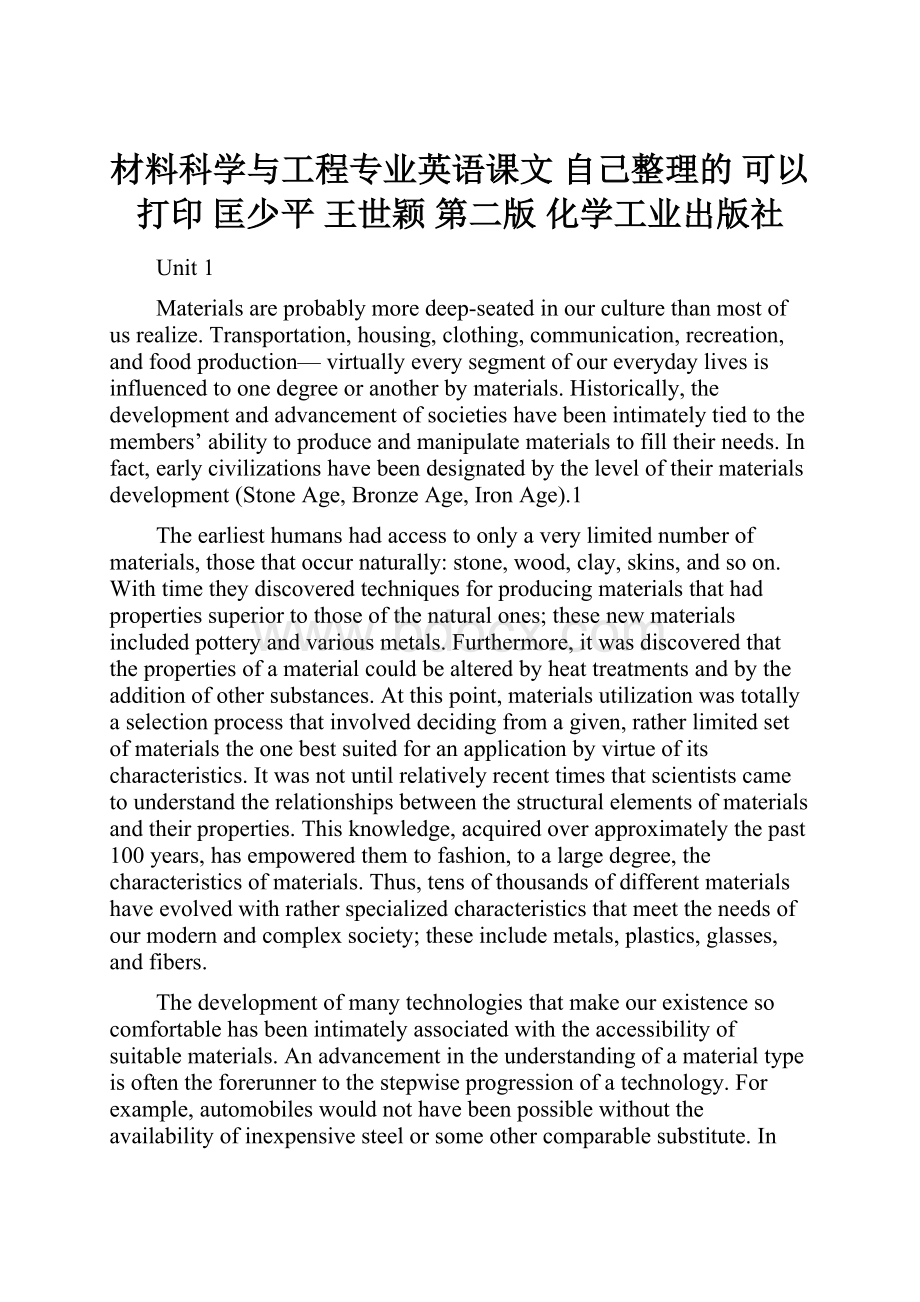材料科学与工程专业英语课文自己整理的 可以打印匡少平 王世颖 第二版 化学工业出版社.docx
《材料科学与工程专业英语课文自己整理的 可以打印匡少平 王世颖 第二版 化学工业出版社.docx》由会员分享,可在线阅读,更多相关《材料科学与工程专业英语课文自己整理的 可以打印匡少平 王世颖 第二版 化学工业出版社.docx(19页珍藏版)》请在冰豆网上搜索。

材料科学与工程专业英语课文自己整理的可以打印匡少平王世颖第二版化学工业出版社
Unit1
Materialsareprobablymoredeep-seatedinourculturethanmostofusrealize.Transportation,housing,clothing,communication,recreation,andfoodproduction—virtuallyeverysegmentofoureverydaylivesisinfluencedtoonedegreeoranotherbymaterials.Historically,thedevelopmentandadvancementofsocietieshavebeenintimatelytiedtothemembers’abilitytoproduceandmanipulatematerialstofilltheirneeds.Infact,earlycivilizationshavebeendesignatedbytheleveloftheirmaterialsdevelopment(StoneAge,BronzeAge,IronAge).1
Theearliesthumanshadaccesstoonlyaverylimitednumberofmaterials,thosethatoccurnaturally:
stone,wood,clay,skins,andsoon.Withtimetheydiscoveredtechniquesforproducingmaterialsthathadpropertiessuperiortothoseofthenaturalones;thesenewmaterialsincludedpotteryandvariousmetals.Furthermore,itwasdiscoveredthatthepropertiesofamaterialcouldbealteredbyheattreatmentsandbytheadditionofothersubstances.Atthispoint,materialsutilizationwastotallyaselectionprocessthatinvolveddecidingfromagiven,ratherlimitedsetofmaterialstheonebestsuitedforanapplicationbyvirtueofitscharacteristics.Itwasnotuntilrelativelyrecenttimesthatscientistscametounderstandtherelationshipsbetweenthestructuralelementsofmaterialsandtheirproperties.Thisknowledge,acquiredoverapproximatelythepast100years,hasempoweredthemtofashion,toalargedegree,thecharacteristicsofmaterials.Thus,tensofthousandsofdifferentmaterialshaveevolvedwithratherspecializedcharacteristicsthatmeettheneedsofourmodernandcomplexsociety;theseincludemetals,plastics,glasses,andfibers.
Thedevelopmentofmanytechnologiesthatmakeourexistencesocomfortablehasbeenintimatelyassociatedwiththeaccessibilityofsuitablematerials.Anadvancementintheunderstandingofamaterialtypeisoftentheforerunnertothestepwiseprogressionofatechnology.Forexample,automobileswouldnothavebeenpossiblewithouttheavailabilityofinexpensivesteelorsomeothercomparablesubstitute.Inourcontemporaryera,sophisticatedelectronicdevicesrelyoncomponentsthataremadefromwhatarecalledsemiconductingmaterials.
MATERIALSSCIENCEANDENGINEERING
Sometimesitisusefultosubdividethedisciplineofmaterialsscienceandengineeringintomaterialsscienceandmaterialsengineeringsubdisciplines.Strictlyspeaking,“materialsscience”involvesinvestigatingtherelationshipsthatexistbetweenthestructuresandpropertiesofmaterials.Incontrast,“materialsengineering”is,onthebasisofthesestructure–propertycorrelations,designingorengineeringthestructureofamaterialtoproduceapredeterminedsetofproperties.2Fromafunctionalperspective,theroleofamaterialsscientististodeveloporsynthesizenewmaterials,whereasamaterialsengineeriscalledupontocreatenewproductsorsystemsusingexistingmaterials,and/ortodeveloptechniquesforprocessingmaterials.Mostgraduatesinmaterialsprogramsaretrainedtobebothmaterialsscientistsandmaterialsengineers.
“Structure”isatthispointanebuloustermthatdeservessomeexplanation.Inbrief,thestructureofamaterialusuallyrelatestothearrangementofitsinternalcomponents.Subatomicstructureinvolveselectronswithintheindividualatomsandinteractionswiththeirnuclei.Onanatomiclevel,structureencompassestheorganizationofatomsormoleculesrelativetooneanother.Thenextlargerstructuralrealm,whichcontainslargegroupsofatomsthatarenormallyagglomeratedtogether,istermed“microscopic,”meaningthatwhichissubjecttodirectobservationusingsometypeofmicroscope.Finally,structuralelementsthatmaybeviewedwiththenakedeyearetermed“macroscopic.”
Thenotionof“property”deserveselaboration.Whileinserviceuse,allmaterialsareexposedtoexternalstimulithatevokesometypeofresponse.Forexample,aspecimensubjectedtoforceswillexperiencedeformation,orapolishedmetalsurfacewillreflectlight.Apropertyisamaterialtraitintermsofthekindandmagnitudeofresponsetoaspecificimposedstimulus.Generally,definitionsofpropertiesaremadeindependentofmaterialshapeandsize.
Virtuallyallimportantpropertiesofsolidmaterialsmaybegroupedintosixdifferentcategories:
mechanical,electrical,thermal,magnetic,optical,anddeteriorative.Foreachthereisacharacteristictypeofstimuluscapableofprovokingdifferentresponses.Mechanicalpropertiesrelatedeformationtoanappliedloadorforce;examplesincludeelasticmodulusandstrength.Forelectricalproperties,suchaselectricalconductivityanddielectricconstant,thestimulusisanelectricfield.Thethermalbehaviorofsolidscanberepresentedintermsofheatcapacityandthermalconductivity.Magneticpropertiesdemonstratetheresponseofamaterialtotheapplicationofamagneticfield.Foropticalproperties,thestimulusiselectromagneticorlightradiation;indexofrefractionandreflectivityarerepresentativeopticalproperties.Finally,deteriorativecharacteristicsrelatetothechemicalreactivityofmaterials.Thechaptersthatfollowdiscusspropertiesthatfallwithineachofthesesixclassifications.
Inadditiontostructureandproperties,twootherimportantcomponentsareinvolvedinthescienceandengineeringofmaterials—namely,“processing”and“performance.“Withregardtotherelationshipsofthesefourcomponents,thestructureofamaterialwilldependonhowitisprocessed.Furthermore,amaterial’sperformancewillbeafunctionofitsproperties.Thus,theinterrelationshipbetweenprocessing,structure,properties,andperformanceisasdepictedintheschematicillustrationshowninFigure1.1.Throughoutthistextwedrawattentiontotherelationshipsamongthesefourcomponentsintermsofthedesign,production,andutilizationofmaterials
WHYSTUDYMATERIALSSCIENCEANDENGINEERING?
Whydowestudymaterials?
Manyanappliedscientistorengineer,whethermechanical,civil,chemical,orelectrical,willatonetimeoranotherbeexposedtoadesignprobleminvolvingmaterials.Examplesmightincludeatransmissiongear,thesuperstructureforabuilding,anoilrefinerycomponent,oranintegratedcircuitchip.Ofcourse,materialsscientistsandengineersarespecialistswhoaretotallyinvolvedintheinvestigationanddesignofmaterials.
Manytimes,amaterialsproblemisoneofselectingtherightmaterialfromthemanythousandsthatareavailable.Thereareseveralcriteriaonwhichthefinaldecisionisnormallybased.Firstofall,thein-serviceconditionsmustbecharacterized,forthesewilldictatethepropertiesrequiredofthematerial.Ononlyrareoccasionsdoesamaterialpossessthemaximumoridealcombinationofproperties.Thus,itmaybenecessarytotradeoffonecharacteristicforanother.Theclassicexampleinvolvesstrengthandductility;normally,amaterialhavingahighstrengthwillhaveonlyalimitedductility.Insuchcasesareasonablecompromisebetweentwoormorepropertiesmaybenecessary.
Asecondselectionconsiderationisanydeteriorationofmaterialpropertiesthatmayoccurduringserviceoperation.Forexample,significantreductionsinmechanicalstrengthmayresultfromexposuretoelevatedtemperaturesorcorrosiveenvironments.Finally,probablytheoverridingconsiderationisthatofeconomics:
Whatwillthefinishedproductcost?
Amaterialmaybefoundthathastheidealsetofpropertiesbutisprohibitivelyexpensive.Hereagain,somecompromiseisinevitable.Thecostofafinishedpiecealsoincludesanyexpenseincurredduringfabricationtoproducethedesiredshape.
Themorefamiliaranengineerorscientistiswiththevariouscharacteristicsandstructure–propertyrelationships,aswellasprocessingtechniquesofmaterials,themoreproficientandconfidentheorshewillbetomakejudiciousmaterialschoicesbasedonthesecriteria.
Unit2
CLASSIFICATIONOFMATERIALS
Solidmaterialshavebeenconvenientlygroupedintothreebasicclassifications:
metals,ceramics,andpolymers.Thisschemeisbasedprimarilyonchemicalmakeupanatomicstructure,andmostmaterialsfallintoonedistinctgroupingoranother,althoughtherearesomeintermediates.Inaddition,therearethecomposites,combinationsoftwoormoreoftheabovethreebasicmaterialclasses.Anotherclassificationisadvancedmaterials—thoseusedinhigh-technologyapplications—viz.semiconductors,biomaterials,smartmaterials,andnanoengineeredmaterials;
Metals
Materialsinthisgrouparecomposedofoneormoremetallicelements(suchasiron,aluminum,copper,titanium,gold,andnickel),andoftenalsononmetallicelements(forexample,carbon,nitrogen,andoxygen)inrelativelysmallamounts.3Atomsinmetalsandtheiralloysarearrangedinaveryorderlymanner(asdiscussedinChapter3),andincomparisontotheceramicsandpolymers,arerelativelydense(Figure1.3).Withregardtomechanicalcharacteristics,thesematerialsarerelativelystiff(Figure1.4)andstrong(Figure1.5),yetareductile(i.e.,capableoflargeamountsofdeformationwithoutfracture),andareresistanttofracture(Figure1.6),whichaccountsfortheirwidespreaduseinstructuralapplications.Metallicmaterialshavelargenumbersofnonlocalizedelectrons;thatis,theseelectronsarenotboundtoparticularatoms.Manypropertiesofmetalsaredirectlyattributabletotheseelectrons.Forexample,metalsareextremelygoodconductorsofelectricity(Figure1.7)andheat,andarenottransparenttovisiblelight;apolishedmetalsurfacehasalustrousappearance.Inaddition,someof